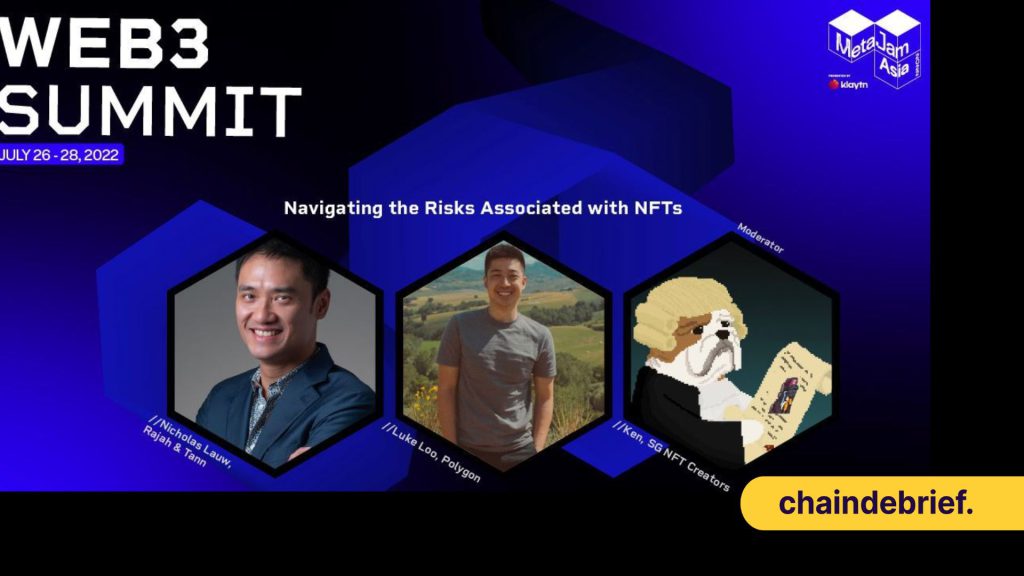MetaJam Summit is happening from the 26th to the 28th of July 2022. It is a phygital summit that will showcase a line-up of keynote speeches, debates, and sharing workshops hosted by leading personnel and speakers from the region’s Web3.0 space.

On the topic of navigating the risks associated with NFTs, we have two distinguished speakers from different fields. First, we have Nichola Lauw, a partner at Rajah and Tann Singapore LLP; next, we have Luke Loo, the NFT lead of Polygon studio.
The moderator is Ken from SG NFT Creators.
Owning the NFT doesn’t mean you own the image
When a consumer purchases an NFT, he/she would definitely own the token but it means he/she owns the image.
“The image is protected by the copyright act as it is an artistic work and there are certain rights to it but the copyright act says nothing about the token.”
Nichola Lauw, Partner at Rajah and Tann Singapore LLP
It is important to know your rights when you purchase the NFT as owning the NFT doesn’t necessarily mean ownership rights to the image or artwork.
How to do due diligence on NFT project?
It is hard to do due diligence on NFT project because it is not as straightforward. There are no terms and conditions laid out so users have to look at every crook and cranny of the project.
One way to do due diligence is to look at the core team and see who is building. Unfortunately, a lot of project founder is not doxxed so it is quite hard to tell if the team is legit or not.
Some question you can ask yourself is: What does the project represent and what does it bring in term of value and art?
There is a saying “The code is Queen”. Red flags are usually hidden deep within the smart contract codes. The best way is to scan the codes of the smart contract and figure out what the codes can and cannot do
Can smart contracts help to navigate risks?
A smart contract is a preset of rules on the blockchain so when the rules are triggered or a set of conditions are met the outcome will happen.
The whole point of a smart contract is that there is no need for a third party to be involved as the smart contract will automatically execute once the conditions are met. This effectively mitigates the risk of the third party.
But then again we are still seeing the third-party risk as they are handling the smart contracts. They are needed to handle the NFT project and to write up the smart contract. While smart contracts help to limit the risk, there’s no doubt that there is an inherent third-party risk.
Scams and rug pull what can be done?
Looking at the current landscape, the majority of the NFT scams all happen on discord. One of the most common ones is when users are anticipating a hype project mint and scammers are sending phishing links on the discord channel.
Scammers will always take advantage of these situations to catch users off guard. Scams are evolving in a way that even NFT veterans will also fall for them.
Unfortunately, there are not much users can do apart from being more vigilant. Most of the ongoing scams in Web 3.0 are no different to traditional scams like phishing links to fake emails. Users just have to be more vigilant and avoid clicking links sent by strangers.
Wzrds NFT incident
Just looked at the @WZRDSxyz contract and yep, they can definitely arbitrarily burn your NFT. It doesn't matter whether it's listed for sale or not, they can burn it (without paying you if it's listed).
— 0xBeans.eth (@0x_Beans) July 12, 2022
They can also arbitrarily transfer your NFT to whoever as well.
Here's how: pic.twitter.com/iKbo5aSsbi
If you don’t know about Wzrds, it made headline because it started burning user’s NFT if it was listed below a certain price. This artificially pumped up the FP of the project making it seem valuable.
This NFT burning mechanism is not something new in the NFT space. It is very common in Solana NFT as a lot of them don’t always get to mint out fully. In certain cases, this mechanism actually benefits the project and holders as it prevents dumping by the whales.
From the legal perspective of things, as long as it is stated in the terms and conditions that the NFT will be burned if it is listed under a certain price, there is nothing much the owner can do. It all boils down to doing your own due diligence before buying or minting the NFT.
Closing thoughts
The panellists shared great insight on how to navigate risk associated with NFTs. They even gave tips on how to do due diligence on NFT project.
While there’s only so much we can do to navigate the risk associated with NFTs, it is still important to take note and safeguard your assets. It is better to be safe than sorry.
Also Read: Metajam 2022: How NFTs Are Revolutionizing Every Industry
[Editor’s Note: This article does not represent financial advice. Please do your research before investing.]
Featured Image Credit: Chain Debrief



































